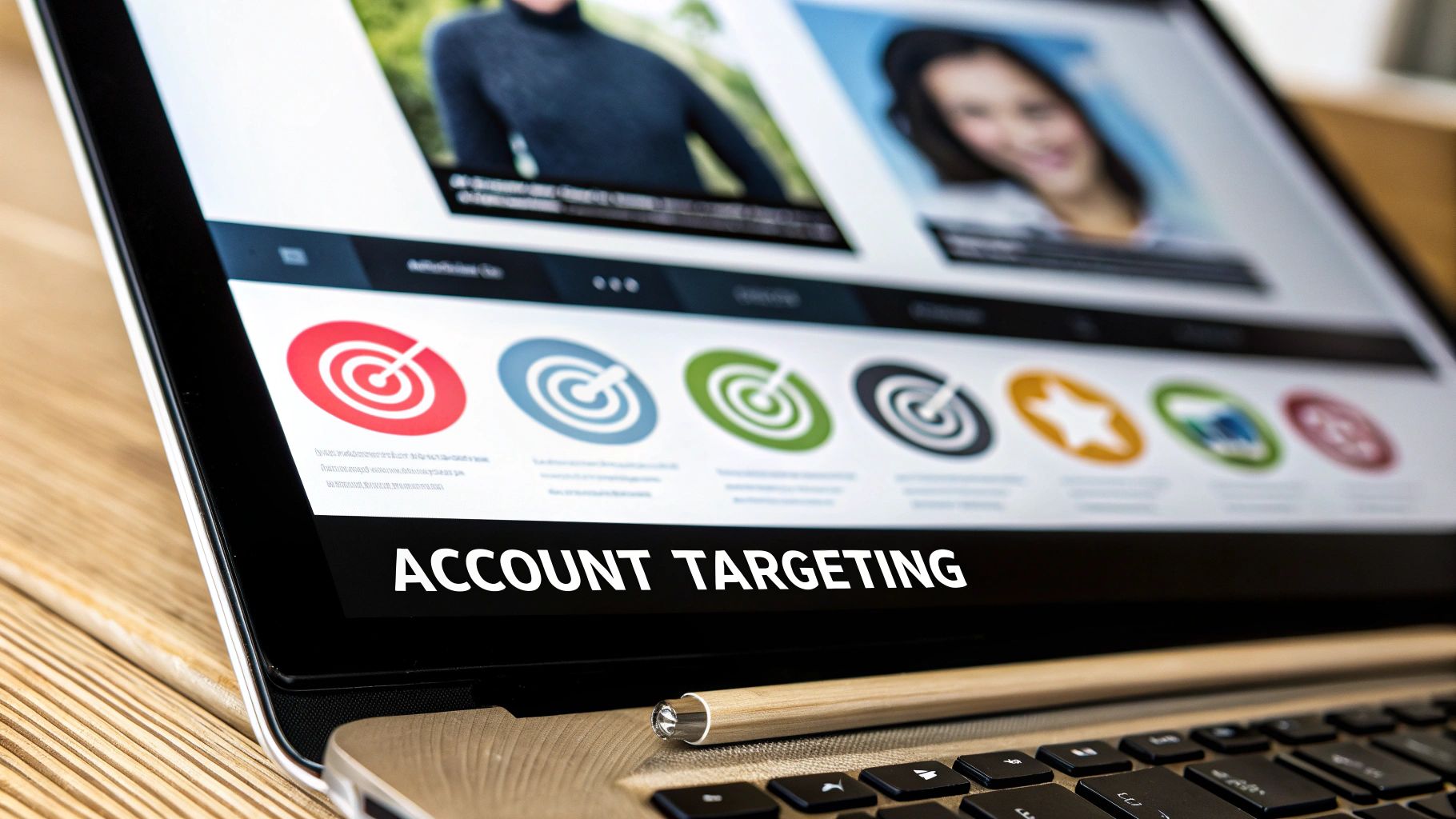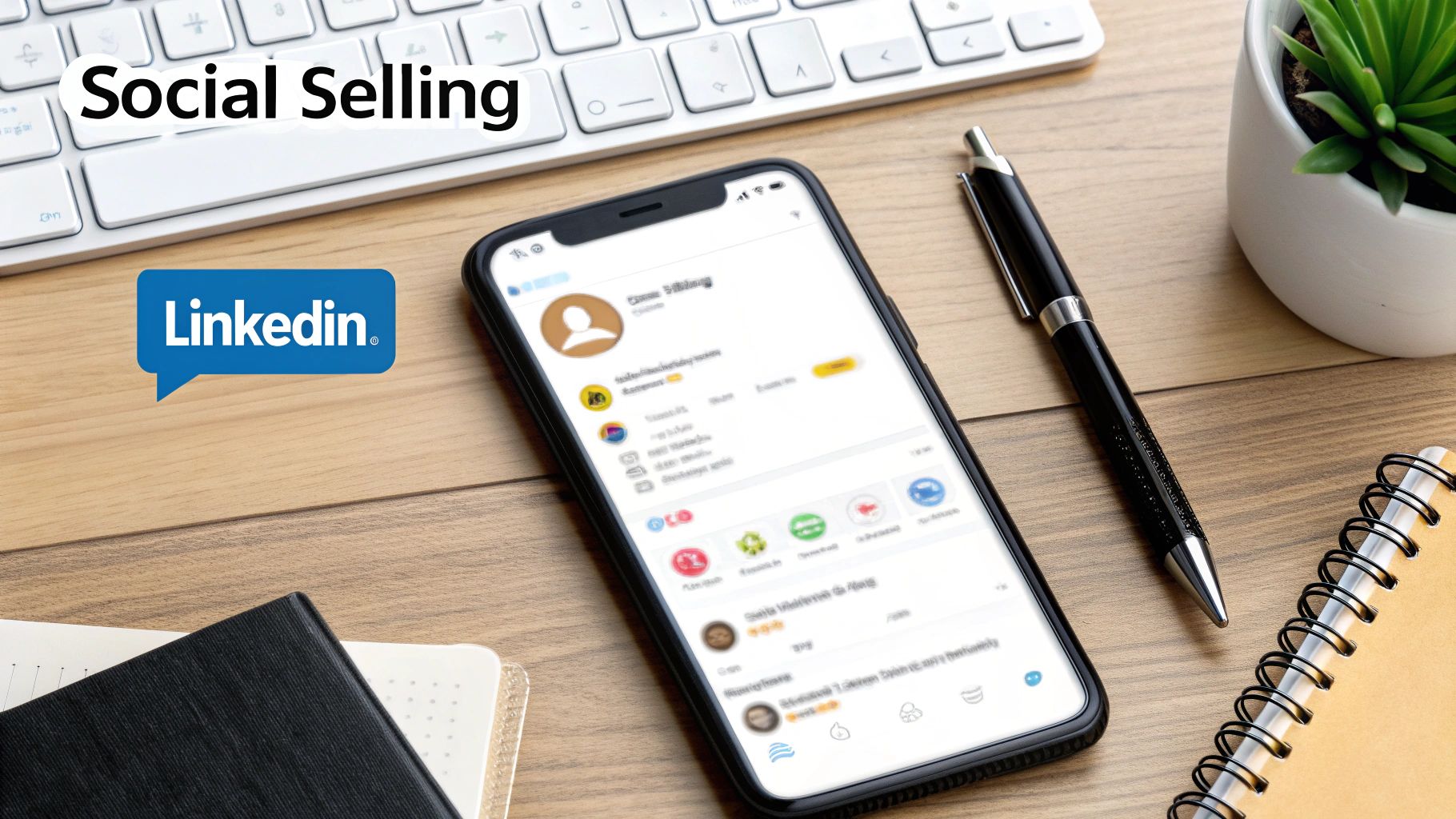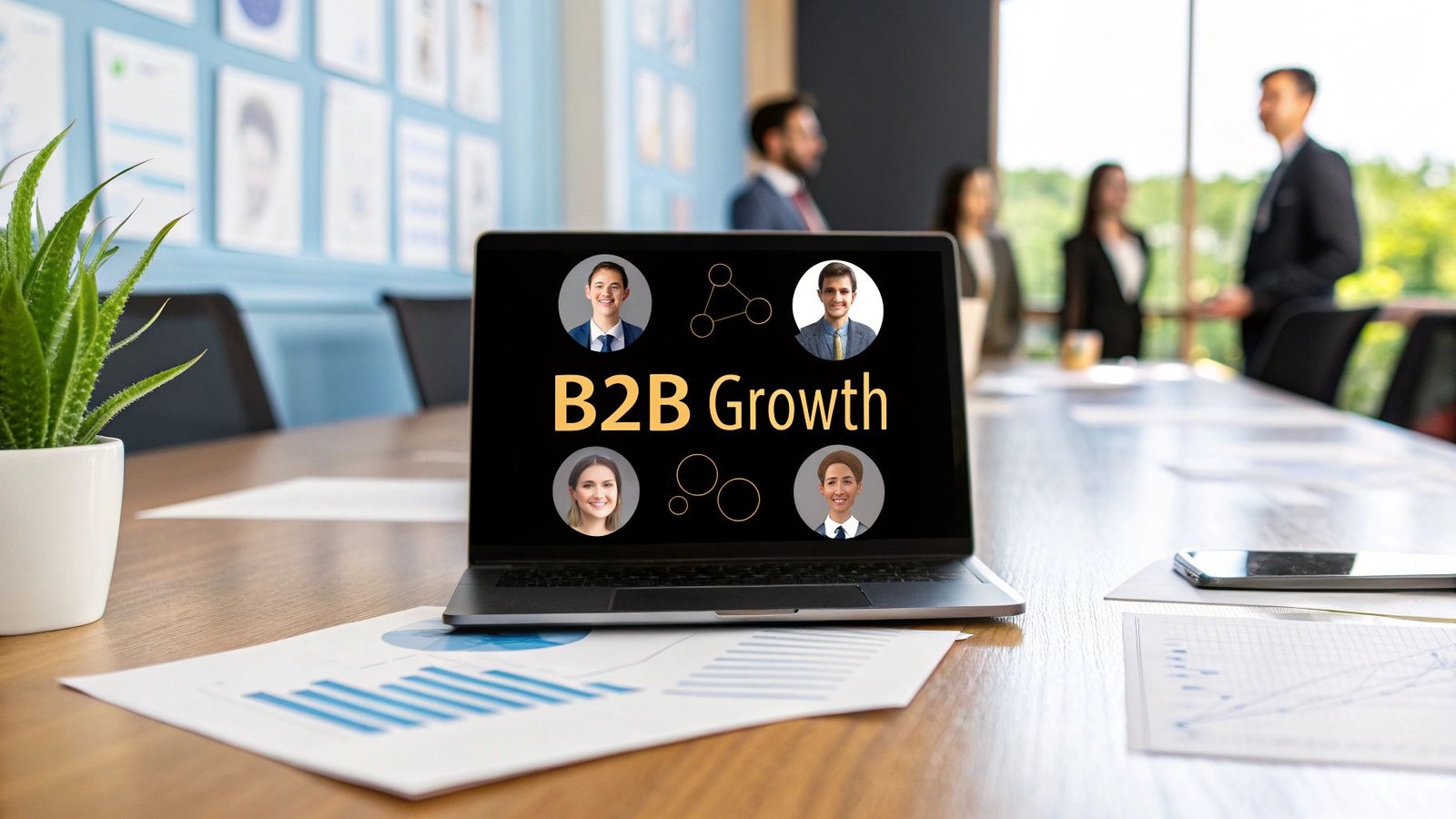In the competitive landscape of 2025, securing a steady stream of high-value clients is the cornerstone of sustainable growth. But with countless channels and tactics available, identifying the most effective B2B customer acquisition strategies can feel overwhelming. This guide cuts through the noise. We've compiled 10 proven, actionable strategies that modern B2B leaders are using to build predictable revenue pipelines.
This is not a theoretical overview; it's a practical blueprint designed for SaaS companies and sales teams. We will break down each strategy, providing clear implementation steps and real-world examples to guide your efforts. Whether you're looking to enhance your brand's authority, execute hyper-targeted campaigns, or scale your outreach, the insights here are designed for immediate application.
Inside, you will find a structured approach to everything from Content Marketing and Account-Based Marketing (ABM) to Strategic Partnerships and LinkedIn Outreach. Prepare to move beyond generic advice and equip your team with the specific tactics needed to attract, engage, and convert your ideal customers. Let's dive into the frameworks that will unlock your next wave of growth.
1. Content Marketing & Thought Leadership
Content marketing is one of the most effective B2B customer acquisition strategies because it shifts the dynamic from outbound selling to inbound attraction. Instead of interrupting potential customers, this approach focuses on creating and distributing valuable, relevant content that addresses their specific pain points and questions. By consistently providing solutions and insights, your company establishes itself as a trusted authority, or thought leader, in its industry.

This strategy builds a foundation of trust long before a sales conversation ever happens. When a prospect is ready to buy, they are more likely to turn to the company that has already been educating them. For example, HubSpot’s extensive marketing blog and free tools attract millions of users, many of whom eventually become paying customers. Similarly, Salesforce's Trailhead platform educates users on their ecosystem, building both expertise and brand loyalty.
How to Implement This Strategy:
- Solve, Don't Sell: Center your content around your audience's challenges. Use keyword research to understand the questions they are asking and create comprehensive resources that provide clear, actionable answers.
- Map Content to the Buyer Journey: Develop different types of content for each stage. Create top-of-funnel blog posts for awareness, mid-funnel whitepapers and webinars for consideration, and bottom-of-funnel case studies for decision-making.
- Leverage Original Research: Stand out by publishing unique data, surveys, or industry reports. This type of content is highly shareable, earns valuable backlinks, and solidifies your position as an industry expert.
2. Account-Based Marketing (ABM)
Account-Based Marketing (ABM) flips the traditional marketing funnel on its head. Instead of casting a wide net to capture many leads, ABM focuses on identifying a select group of high-value target accounts and treating them as markets of one. This hyper-personalized approach is one of the most powerful B2B customer acquisition strategies for companies with high-value, complex sales cycles, as it aligns marketing and sales efforts to engage key decision-makers within a specific organization.

The core principle is quality over quantity. By concentrating resources on accounts with the highest revenue potential, you create deeply personalized campaigns that resonate with the entire buying committee. For example, a company like Snowflake might run targeted ad campaigns and host exclusive events for key executives at specific Fortune 500 companies. Similarly, Demandbase uses its own platform to deliver a unique website experience for each visiting target account, proving the value of its product firsthand. If you're looking for more ways to integrate this approach, you can learn more about ABM and other demand generation strategies.
How to Implement This Strategy:
- Define Your Ideal Customer Profile (ICP): Start by identifying the firmographic and technographic characteristics of your best customers. Use this data to build a small, manageable list of high-value target accounts to focus on initially.
- Research and Personalize: Invest heavily in account research to understand each company's specific challenges, goals, and organizational structure. Create account-specific messaging and value propositions that speak directly to their needs.
- Coordinate Multi-Channel Outreach: Align sales and marketing teams to orchestrate a unified outreach sequence across multiple touchpoints. This could include personalized emails, targeted social media ads, direct mail, and tailored content, all aimed at engaging the buying committee.
3. Strategic Partnerships & Channel Development
Strategic partnerships are a powerful force multiplier among B2B customer acquisition strategies, allowing you to tap into new markets by leveraging the trust and audience of another company. Instead of building a customer base from scratch, you form alliances with complementary, non-competing businesses to create mutually beneficial growth. This approach provides a warm introduction to prospects who already trust your partner, significantly shortening the sales cycle.

This model is about creating an ecosystem where everyone wins. For instance, Shopify's extensive app and partner program allows developers to build solutions on its platform, which in turn makes Shopify more valuable to merchants. Similarly, Salesforce's AppExchange and consulting partner network help customers extend the platform's functionality, driving both adoption and loyalty. These partnerships create new revenue streams and provide credible, third-party validation for your solution.
How to Implement This Strategy:
- Identify Complementary Partners: Look for businesses whose products or services are used by your ideal customer profile but do not directly compete with your own. For example, a project management software could partner with a time-tracking tool.
- Define Clear Mutual Value: Establish clear goals, responsibilities, and commission structures from the beginning. A strong partnership agreement should outline what each party gives and gets, ensuring alignment and preventing future conflicts.
- Enable Your Partners for Success: Don't just sign an agreement and walk away. Provide comprehensive training, marketing materials, and dedicated support to empower your partners to effectively represent and sell your product.
- Develop Joint Go-to-Market Plans: Collaborate on marketing campaigns, co-hosted webinars, or bundled offerings. A joint strategy ensures you are reaching the right audience with a unified and compelling message.
4. Social Selling & LinkedIn Outreach
Social selling is a powerful B2B customer acquisition strategy that moves beyond traditional cold outreach by leveraging social networks, primarily LinkedIn, to find, connect with, and nurture sales prospects. This approach prioritizes building authentic relationships and establishing credibility by sharing valuable insights and engaging in meaningful conversations. It transforms the sales process from a direct pitch into a consultative partnership.

Instead of a cold call, a social seller might engage with a prospect's post, share a relevant article, and then initiate a personalized conversation about a shared challenge. This method is highly effective because it builds trust before a sales discussion begins. For instance, IBM's global social selling program trained thousands of employees to use platforms like LinkedIn to generate new leads, resulting in a significant ROI by positioning their team as industry experts.
How to Implement This Strategy:
- Provide Value Before You Pitch: Share relevant industry articles, comment thoughtfully on prospects' posts, and offer insights without any expectation of a sale. Your goal is to become a trusted resource, not just another salesperson.
- Personalize Every Interaction: Avoid generic templates. Reference a prospect’s recent post, a mutual connection, or a company announcement in your outreach message to show you've done your research.
- Utilize LinkedIn Sales Navigator: Leverage this powerful tool for advanced search filters, lead recommendations, and tracking prospect activity. This allows you to identify and engage with the right decision-makers at the right time.
5. Search Engine Optimization (SEO) for B2B
Search Engine Optimization is one of the most powerful long-term B2B customer acquisition strategies, designed to attract high-intent prospects who are actively looking for solutions on search engines like Google. Unlike paid advertising, which stops when you stop paying, SEO focuses on earning organic visibility by optimizing your website’s content, technical structure, and authority. The goal is to rank for keywords and phrases your target audience uses to find products or services like yours.
This strategy captures demand rather than creating it, connecting you with decision-makers at the exact moment they are evaluating solutions. Companies like Atlassian excel at this, with comprehensive documentation and guides that rank for thousands of technical queries, drawing in developers and project managers. Similarly, Ahrefs attracts its core audience of marketers by creating authoritative content that answers their most pressing SEO-related questions, turning searchers into customers.
How to Implement This Strategy:
- Focus on High-Intent Keywords: Target long-tail keywords that signal commercial intent, such as "best CRM software for small businesses" or "enterprise cybersecurity solutions." These specific queries attract prospects who are closer to making a purchasing decision.
- Build Topic Clusters: Organize your content around core business themes. Create a central "pillar" page for a broad topic (e.g., "Account-Based Marketing") and link out to more detailed "cluster" articles on related subtopics, establishing your site as an authority.
- Prioritize Technical Health: Ensure your website is technically sound. Focus on fast page-loading speeds, a mobile-friendly design, and a clean site architecture to provide a seamless user experience and meet search engine ranking standards.
6. Email Marketing & Lead Nurturing
Email marketing remains one of the most powerful and direct B2B customer acquisition strategies for building and maintaining relationships. This approach focuses on systematically nurturing leads through targeted email campaigns that provide value, educate prospects on solutions, and guide them through the buyer's journey. It combines automation with deep personalization to move leads from initial awareness to purchase-readiness without aggressive sales tactics.
This strategy excels at keeping your brand top-of-mind. Instead of a single touchpoint, lead nurturing creates an ongoing dialogue, building trust over time. For example, HubSpot’s comprehensive onboarding email sequences educate new users on their platform, while Mailchimp’s educational series provides small businesses with valuable marketing tips, positioning them as an indispensable resource. This consistent, value-driven communication ensures that when a prospect is ready to buy, your company is their first choice. For a deeper dive, you can explore more about B2B lead nurturing strategies on nordicleaddatabase.com.
How to Implement This Strategy:
- Segment Your Lists: Group contacts based on industry, company size, job title, and behavior (e.g., content downloaded, pages visited). This allows you to send highly relevant messages that resonate with specific audience needs.
- Provide Clear Value in Every Email: Each email should offer something useful, whether it's an insightful article, an invitation to a webinar, or a helpful tip. Avoid making every message a sales pitch.
- Use Automation and Personalization: Implement automated drip campaigns triggered by user actions. Use personalization tokens beyond just the first name, such as referencing their company or a resource they engaged with, to make communications feel one-to-one.
7. Webinars & Virtual Events
Webinars and virtual events are a powerful B2B customer acquisition strategy because they offer a direct, interactive channel to engage with prospects in real time. Instead of relying on static content, this approach allows you to demonstrate expertise, showcase products, and build personal connections through live Q&A sessions and discussions. This format accelerates the trust-building process and generates highly qualified leads from an engaged, captive audience.
This strategy excels at moving prospects through the consideration and decision stages of the buyer's journey. By providing immense value upfront, you position your brand as a helpful expert. For example, Salesforce’s Trailhead Live events offer free, expert-led sessions on their platform, while Microsoft’s Azure technical deep-dives attract developers and IT professionals by addressing complex technical challenges, ultimately driving product adoption and sales.
How to Implement This Strategy:
- Focus on a Singular Pain Point: Design each webinar around solving one specific, pressing problem for your target audience. Create compelling titles that promise a clear, tangible outcome, such as "How to Cut Your SaaS Churn Rate by 30% in 90 Days."
- Promote Across Multiple Channels: Announce your event on social media, in your newsletter, through partner collaborations, and on your website. Use a clear registration landing page that highlights the key takeaways and introduces the speakers.
- Segment Your Follow-Up: After the event, send tailored communications. Provide attendees with the recording and a special offer, while sending non-attendees the recording and an invitation to your next event to re-engage them.
8. Paid Advertising & PPC Campaigns
While inbound strategies build long-term momentum, paid advertising provides immediate visibility and control, making it a powerful B2B customer acquisition strategy for generating qualified leads quickly. Pay-per-click (PPC) campaigns on platforms like Google Ads and LinkedIn allow you to target decision-makers with surgical precision based on job title, company size, industry, and search intent. This approach places your solution directly in front of prospects actively looking for what you offer.
Unlike organic methods that take time to yield results, a well-optimized paid campaign can drive traffic and conversions from day one. For example, Slack runs highly targeted LinkedIn campaigns aimed at CTOs and IT directors in enterprise companies, while Asana uses Google Ads to capture users searching for "project management software." These campaigns succeed by combining precise targeting with messaging that speaks directly to a specific professional need, delivering a measurable return on investment.
How to Implement This Strategy:
- Refine Targeting and Use Negative Keywords: Go beyond basic demographics. On platforms like LinkedIn, layer targeting by seniority, skills, and group membership. In Google Ads, use an extensive list of negative keywords to filter out irrelevant searches and avoid wasting your budget on unqualified clicks.
- Create Dedicated, High-Converting Landing Pages: Never send paid traffic to your homepage. Design a unique landing page for each campaign that mirrors the ad's messaging and has a single, clear call-to-action (CTA), such as "Request a Demo" or "Download the Whitepaper."
- Focus on Conversion Tracking and ROI: Implement robust conversion tracking to measure what truly matters, whether it's a form submission, a demo request, or a trial signup. This data is essential for optimizing bids, ad copy, and targeting to maximize your return on ad spend (ROAS).
9. Referral Programs & Customer Advocacy
Referral programs formalize one of the most powerful B2B customer acquisition strategies: word-of-mouth marketing. This approach involves creating a structured system that incentivizes your happiest customers to become active brand advocates. Instead of hoping for referrals, you actively encourage and reward them, turning your existing customer base into a high-trust, low-cost acquisition channel.
This strategy works because a recommendation from a trusted peer is far more credible than any marketing message. When a satisfied client refers a new prospect, that lead arrives with a pre-established level of trust and a clearer understanding of your value. For example, Dropbox famously achieved explosive growth by offering free storage to both the referrer and the new user, a simple yet powerful two-sided incentive. Similarly, Slack's organic growth is heavily fueled by users inviting their colleagues and entire teams to the platform.
How to Implement This Strategy:
- Make Referrals Simple and Rewarding: Design a frictionless referral process. Provide customers with a unique link or a pre-written email they can easily share. Ensure the reward, whether it's a discount, credit, or gift card, is valuable to both parties.
- Identify and Nurture Advocates: Use metrics like Net Promoter Score (NPS) or product usage data to identify your most enthusiastic customers. Engage with these advocates personally, thank them for their loyalty, and invite them to your referral program.
- Provide Tools and Resources: Equip your customers with the materials they need to refer effectively. This could include a simple dashboard to track referrals, marketing collateral, or talking points that highlight your key benefits.
10. Sales Development & Outbound Prospecting
While inbound marketing attracts leads, outbound prospecting proactively seeks them out. This is one of the most direct B2B customer acquisition strategies, involving dedicated Sales Development Representatives (SDRs) who identify, research, and engage ideal customer profiles. Rather than waiting for interest, this method initiates conversations and creates opportunities that might not have surfaced otherwise.
The core of this strategy is a structured, scalable process for generating a predictable pipeline of qualified leads. Companies like Outreach.io and SalesLoft have built entire platforms around optimizing this multi-channel approach. By combining personalized emails, cold calls, and social media engagement, SDRs build rapport and qualify prospects before handing them off to account executives, ensuring a higher close rate. Effective outbound lead generation acts as a powerful engine for consistent growth.
How to Implement This Strategy:
- Define Your Ideal Customer Profile (ICP): Create a highly specific profile of your perfect customer, including industry, company size, revenue, and key decision-maker titles. Use this to focus your research and outreach efforts.
- Adopt a Multi-Touch Cadence: Don't rely on a single email. Develop a sequence of 8-12 touchpoints across multiple channels (email, phone, LinkedIn) over several weeks to maximize the chances of engagement.
- Personalize at Scale: Research each prospect to find a relevant hook, like a recent company announcement, a new role, or a shared connection. Use this to craft a personalized opening line that demonstrates you've done your homework.
- Focus on Value, Not Features: Your initial outreach should focus on solving a potential business problem, not listing product features. Frame your message around a compelling value proposition that sparks curiosity.
B2B Customer Acquisition Strategies Comparison
| Strategy | Implementation Complexity 🔄 | Resource Requirements ⚡ | Expected Outcomes 📊 | Ideal Use Cases 💡 | Key Advantages ⭐ |
|---|---|---|---|---|---|
| Content Marketing & Thought Leadership | Medium to High – requires consistent content creation | Moderate – content creators, research, time | Long-term brand authority, inbound leads (slow build) | Brand building, lead generation, SEO improvement | Builds trust, cost-effective, evergreen content, SEO boost |
| Account-Based Marketing (ABM) | High – detailed research & personalized campaigns | High – account research, content personalization | Higher conversion rates, clearer ROI, deal size growth | Targeting high-value accounts, sales-marketing alignment | Personalized experience, efficient resource use, measurable ROI |
| Strategic Partnerships & Channel Development | Medium to High – requires partner management | Moderate to High – partner enablement and coordination | Expanded reach, new customer bases through alliances | Leveraging complementary businesses, geographic expansion | Access to established customers, shared resources, credibility |
| Social Selling & LinkedIn Outreach | Medium – ongoing engagement needed | Moderate – profile optimization, content & messaging | Authentic relationships, higher response rates | Relationship building, social engagement on LinkedIn | Cost-effective, leverages social proof, valuable prospect data |
| SEO for B2B | High – requires technical and content expertise | Moderate – SEO specialists and tools | Sustainable high-intent organic traffic, brand credibility | Long-term organic growth and visibility | Cost-effective, compounding results, builds trust |
| Email Marketing & Lead Nurturing | Medium – requires automation setup & content creation | Moderate – email platform, content, CRM integration | Scalable nurturing, high ROI, detailed tracking | Lead nurturing, personalized communication | Automated, cost-effective, maintains awareness |
| Webinars & Virtual Events | High – event planning & technical setup | Moderate to High – presenters, tech platform | High-value leads, direct prospect interaction | Product demos, thought leadership, educational engagement | Direct interaction, reusable content, trust-building |
| Paid Advertising & PPC Campaigns | Medium – campaign setup & ongoing optimization | High – ad spend, management tools | Immediate traffic and visibility, measurable ROI | Quick lead generation, targeted prospecting | Immediate results, precise targeting, scalable budget |
| Referral Programs & Customer Advocacy | Medium – program design and management | Moderate – incentive systems, customer engagement | High-conversion warm referrals, brand loyalty | Leveraging satisfied customers for growth | Low acquisition cost, authentic social proof, loyalty boost |
| Sales Development & Outbound Prospecting | High – requires team, training, compliance | High – dedicated SDR teams, CRM, multi-channel tools | Predictable pipeline, immediate outreach results | Direct prospect engagement, pipeline acceleration | Controlled outreach volume, personalization, scalable |
Building Your Integrated Acquisition Engine
The journey through these ten powerful B2B customer acquisition strategies reveals a crucial truth: there is no single magic bullet for sustainable growth. Relying on just one tactic, whether it's outbound prospecting or content marketing, creates a fragile system vulnerable to market shifts and algorithm changes. The most resilient and successful SaaS and sales teams understand that the goal isn't to master every strategy at once, but to build an integrated, multi-channel acquisition engine that works in harmony.
The key lies in strategic integration. Think of these strategies not as isolated options on a menu, but as interconnected gears. Your SEO and content marketing efforts create the foundational inbound gravity, pulling prospects into your orbit. From there, your email nurturing sequences and webinar events can engage those leads, building trust and demonstrating value. Simultaneously, your ABM and social selling campaigns can target high-value accounts with surgical precision, leveraging the insights and authority established by your broader marketing efforts. This synergy is what transforms disparate activities into a predictable revenue-generating machine.
Your Path to a Scalable Acquisition Model
Getting started can feel overwhelming, but progress is made through methodical action. Instead of attempting to implement all ten strategies simultaneously, focus on a phased approach that aligns with your current business stage and resources.
- Phase 1: Build Your Foundation. Start by mastering one or two foundational inbound strategies. Content Marketing & SEO are the perfect pair, as they create long-term assets that generate compounding returns over time. This creates a consistent flow of qualified traffic and leads.
- Phase 2: Activate and Engage. Once your foundation is in place, layer on strategies designed to actively engage that audience. Email Marketing & Lead Nurturing and Webinars & Virtual Events are excellent next steps to convert passive interest into active sales conversations.
- Phase 3: Accelerate with Precision. With a steady stream of inbound interest, you can now add targeted, high-touch strategies to accelerate growth. This is the ideal time to launch Account-Based Marketing (ABM) campaigns or empower your team with Social Selling and Sales Development initiatives.
This layered approach ensures that each new strategy you add is supported by the ones that came before it. Your outbound prospecting becomes far more effective when prospects have already heard of your brand through your content. Your ABM campaigns land with greater impact because your target accounts have already engaged with your thought leadership.
Ultimately, the most effective B2B customer acquisition strategies are those that are chosen thoughtfully, implemented diligently, and measured obsessively. Continuously analyze your data, listen to customer feedback, and remain agile enough to reallocate resources to the channels delivering the highest ROI. By treating customer acquisition as a dynamic system rather than a static checklist, you build not just a sales pipeline, but a durable competitive advantage that will fuel your growth for years to come.
Ready to supercharge your outbound and ABM strategies in Northern Europe? A successful campaign is built on accurate, reliable data. The Nordic Lead Database provides the verified contact information you need to connect directly with key decision-makers across the Nordic region, ensuring your message reaches the right people every time. Explore the Nordic Lead Database and fuel your acquisition engine today.
